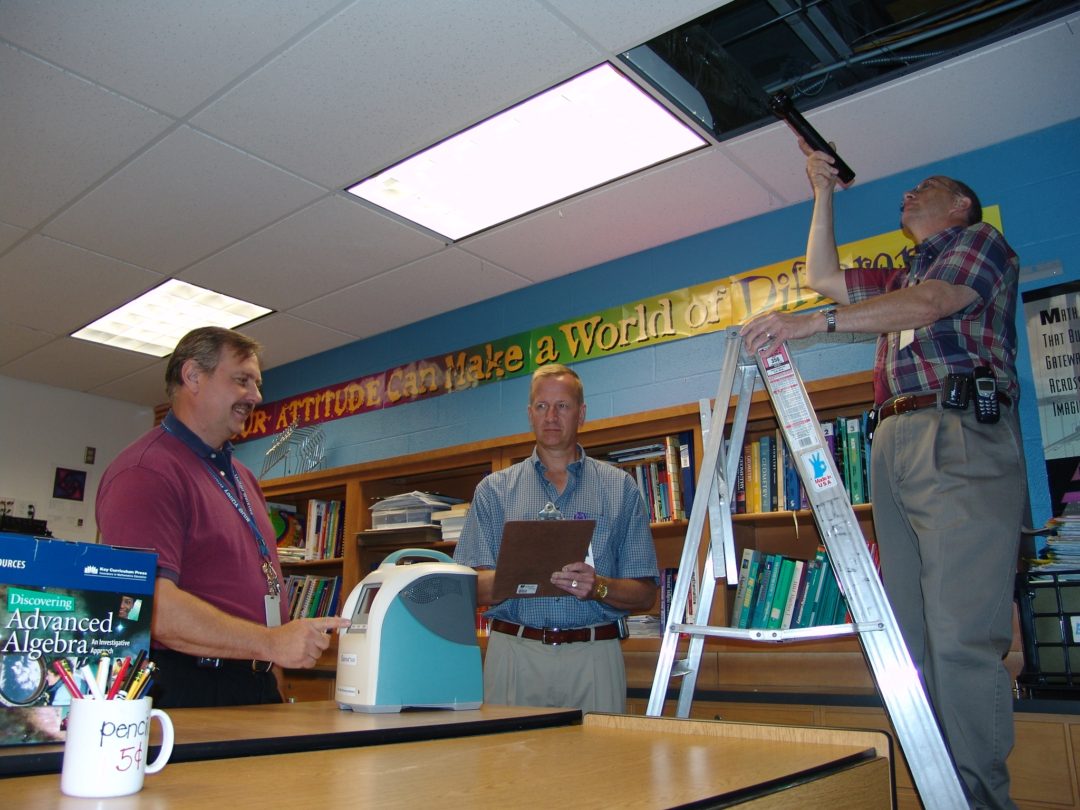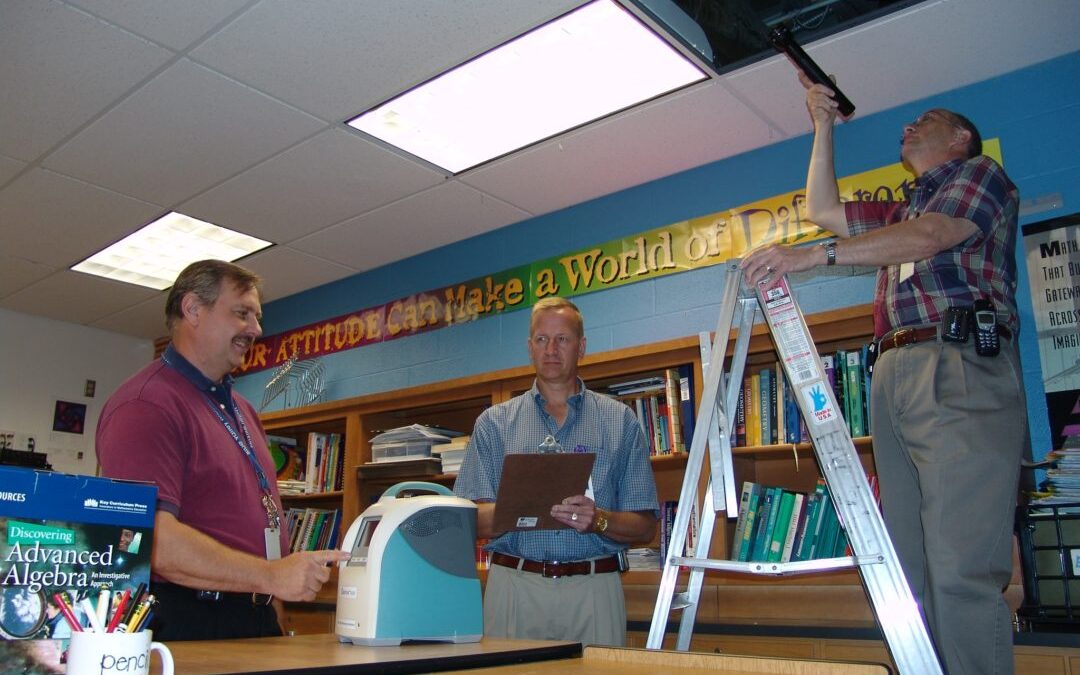By. Cyndy Merse, GSNN Content Writer
Blue Valley School District (BVSD) in Overland Park, Kansas is committed to providing opportunities for academic and personal growth for each of its 22,023 students. This commitment was a driving force behind the district’s adoption of a comprehensive indoor air quality (IAQ) program in 2000. In addition to addressing increased parental interest in environmental issues, BVSD wanted to ensure its students had the healthiest learning environment in which to learn and succeed.
Framework for Success
BVSD turned to the Environmental Protection Agency’s (EPA) IAQ Tools for Schools Framework to bring together the district’s successful existing programs (e.g., building envelope program, preventive maintenance program) and design a plan that addresses IAQ through high performance building design. For BVSD, this meant not only incorporating design elements in schools that have a positive impact on IAQ, but recognizing how these elements (e.g., a strong building envelope, highly insulated roofs, efficient mechanical systems) contribute to healthy learning environments.
Using the Tools for Schools Program’s guidance, BVSD identified procedures, resources, and personnel that were key for improving their facilities management plan. The district also adapted their existing standard operating procedures (SOPs) for facility design and capital construction projects, the building envelope, and mechanical programs to establish new IAQ protocols, and tied the new SOPs to the goal of creating healthier learning environments that promote student success. This link was deemed particularly important in persuading school decision-makers and staff to buy-in to the IAQ program and support its activities.
On-going Assessment
Constant monitoring and assessment are at the heart of BVSD’s IAQ program. The district’s IAQ team conducts frequent walkthroughs and employs a suite of sensing devices to measure important IAQ indicators, including temperature, humidity, air flow and ventilation rates, and CO2 levels, among others. The assessment data is compared to baseline IAQ information that has been collected for each school to better understand what is going on in a particular school’s environment and identify inconsistencies. Using technology to track and monitor IAQ indicators allows the district IAQ team to gather data more quickly than they could in the past, which in turn enables team members to develop solutions faster to prevent potential IAQ problems.
A Breathe of Fresh Air
One of the ways BVSD has been improving IAQ is by removing underperforming systems and replacing them with displacement ventilation (DV) systems. Traditional air delivery systems introduce fresh air from the ceiling. To reach building occupants (i.e., students and teachers), the fresh air must fight its way through stale, warm air that may be full of CO2 and other contaminants. DV systems deliver fresh air closer to the floor where students and teachers normally sit. This means the fresh air reaches occupants quicker, and is less likely to be contaminated by CO2 and other particulates. The district’s success rate with installing DV systems has been very good; in one school alone, the fresh air ventilation rate was improved by over 50% and overall building energy consumption was reduced by 17%. BVSD has been gradually introducing DV systems in 1-2 schools per year and aspires to outfit all of its schools with DV technology.

Photo|Blue Valley Schools
IAQ is a Team Effort
BSVD’s IAQ team is a true interdisciplinary collaboration. The team is led by an IAQ coordinator, the “go-to guy” for IAQ in the district as well as a program ambassador to key district decision-makers and school staff. Other team members include staff from design and construction, risk and safety, energy, operations and maintenance, and custodial departments. The IAQ team meets on a regular basis to exchange information and stay abreast of IAQ issues and concerns. They also meet monthly with members of the Board of Education so these key school leaders understand what is being done to improve IAQ and the learning environment for the district’s students.
Another major component of BVSD’s IAQ program is educating facilities staff about IAQ. Custodians are considered the IAQ team’s “eyes and ears” since they are in the school buildings every day. BVSD trains its custodians to conduct walkthroughs, identify the root causes of IAQ problems, document potential IAQ issues, and train their colleagues to do the same. BVSD’s IAQ team also works with principals on a regular basis to educate them about the IAQ program and share a list of the roles, responsibilities, and contact information for facilities department staff. As a result, of this engagement, many BVSD principals have become active site managers.
Communication and Accountability are Key
Communication has been essential in the success of BVSD’s IAQ program. From the start, IAQ team members stressed the importance of good IAQ and its link to student learning and the overall classroom experience. By tying the IAQ program to a goal the district cared about (student academic achievement), the IAQ team was able to build the support they needed to implement the program and sustain it over the last 16 years. BVSD also communicates regularly with parents, school stakeholders, and the community about the need for an IAQ program, its successes, and how the program protects students and promotes healthy, positive learning environments.
BVSD also believes in holding itself accountable for its IAQ program. The district has incorporated its IAQ goals, plans, and measures into its strategic plan, facility operations plans, staff training programs, and operating manuals. Doing this has not only institutionalized the IAQ program, but has made BVSD publicly accountable for the IAQ program’s performance by evaluating progress against their goals. Another way BVSD demonstrates accountability is by being as transparent as possible with the community and everyone involved in the IAQ program. The IAQ team follows up on complaints within 24 hours and communicates frequently with the complainant, informing them of what was found, how they intend to address the issue, and when they expect a resolution. Taking this a step further, BVSD solicits feedback through annual surveys of building occupants that asks them to rate the school’s indoor environment as well as the performance of the IAQ team.
Positive Impact on Students
Since implementing its IAQ program in 2000, BVSD has noted a number of positive results including fewer per capita IAQ concerns per year, a decrease in lost instructional time due to facility issues, and reduced operating costs due to IAQ upgrades. Most significant, however, has been the impact on student academic performance. BVSD students have demonstrated dramatic increases in math and reading scores on standardized tests since the IAQ program was implemented, and BVSD is the only district with over 20,000 students in the nation that has met the Adequate Yearly Progress guidelines for the entire district.
BVSD’s focus on student health and performance through improved IAQ has garnered national attention. In 2003, BVSD was recognized by the EPA with an IAQ Tools for Schools National Excellence Award. Two years later, BVSD received EPA’s IAQ Tools for Schools National Sustained Excellence Award and in 2007 was awarded EPA’s IAQ Tools for Schools National Mentorship Award. These awards serve to validate the district’s efforts to ensure that its students have the best learning environments possible for their academic success.
Best Practices
BVSD recommends the following best practices for schools and school districts looking to implement or improve an IAQ program.
- Start small. IAQ programs take time to implement and show results. Set reasonable goals and find opportunities to improve IAQ that cost little to no money. Small wins go a long way to generating momentum and support for a program. As noted by Dave Hill, Executive Director of Facilities and Operations for BVSD: “Our program’s success didn’t materialize overnight. It started with a vision and expectation of excellence, and we have continued to push the program forward at every opportunity.”
- Build a district IAQ team. Build a group that represents stakeholders from across the district, from school leaders and Board members to custodial and maintenance staff. Provide training and education on IAQ so everyone involved understands their roles and responsibilities in implementing the program.
- Plan your IAQ activities. Include short- and long-term activities and IAQ goals in the district’s strategic plan and SOPs so they become ingrained in the district’s culture and daily operations. Be sure to establish metrics that can be used to measure progress against the program’s goals.
- Communicate widely and often. Openly communicate IAQ program benefits, successes, and challenges with everyone involved as well as the larger school community. Being transparent about the work being done will help maintain support and enthusiasm for the program.
- Always look for ways to improve. Be open to suggestions and recommendations from both program participants and building occupants. Stay abreast of new technology and techniques that can be employed to further improve school IAQ.
References
Interview with Dave Hill, AICP, REFP, Executive Director of Facilities and Operations, Blue Valley School District, Kansas
Dave Hill is the Executive Director of Facilities and Operations for BVSD in Overland Park, Kansas. He has published articles in professional journals and presented at several local and national conferences and symposiums on school facility planning and design, site planning, enrollment forecasting and demographics, LEED and environmental design, and indoor air quality.
Blue Valley: Envisioning Excellence: Lessons from Effective School Indoor Air Quality Programs – A Snapshot of Profiles in Excellence. Environmental Protection Agency. (www.epa.gov/iaq-schools/blue-valley-envisioning-excellence-lessons-effective-school-indoor-air-quality-programs)
Creating Exceptional Learning Environments through Comprehensive Indoor Air Quality Management Webinar: Transcript and Slides. Environmental Protection Agency. May 21, 2013. (www.epa.gov/indoor-air-quality-iaq/creating-exceptional-learning-environments-through-comprehensive-indoor-air)
Hill, David M. “Why a Healthy School Matters.” Educational Facility Planner. Vol. 42: Issue 4. 2008. Pgs. 26-29 (http://media.cefpi.org/HealthyHPS.pdf)
How to Approach Your IAQ Upgrade from Dave Hill. FacilitiesNet. June 20, 2007. (www.facilitiesnet.com/iaq/audiovideo/How-to-Approach-Your-IAQ-Upgrade-from-Dave-Hill–180)




